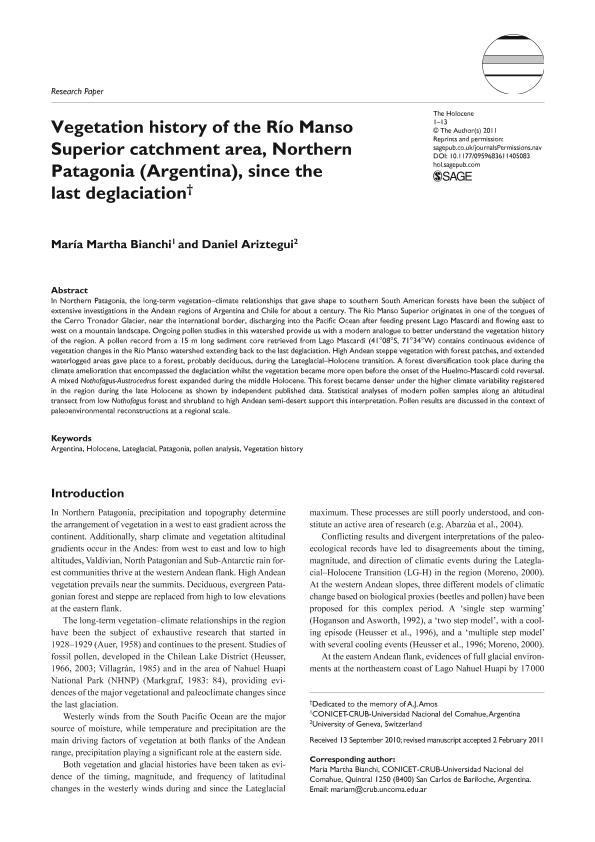Mostrar el registro sencillo del ítem
dc.contributor.author
Bianchi, Maria Martha

dc.contributor.author
Ariztegui, Daniel
dc.date.available
2023-04-20T13:52:22Z
dc.date.issued
2012-11
dc.identifier.citation
Bianchi, Maria Martha; Ariztegui, Daniel; Vegetation history of the Río Manso Superior catchment area, Northern Patagonia (Argentina), since the last deglaciation; Sage Publications Ltd; Holocene (Seven Oaks); 22; 11; 11-2012; 1283-1295
dc.identifier.issn
0959-6836
dc.identifier.uri
http://hdl.handle.net/11336/194739
dc.description.abstract
In Northern Patagonia, the long-term vegetation-climate relationships that gave shape to southern South American forests have been the subject of extensive investigations in the Andean regions of Argentina and Chile for about a century. The Río Manso Superior originates in one of the tongues of the Cerro Tronador Glacier, near the international border, discharging into the Pacific Ocean after feeding present Lago Mascardi and flowing east to west on a mountain landscape. Ongoing pollen studies in this watershed provide us with a modern analogue to better understand the vegetation history of the region. A pollen record from a 15 m long sediment core retrieved from Lago Mascardi (41°08°S, 71°34°W) contains continuous evidence of vegetation changes in the Río Manso watershed extending back to the last deglaciation. High Andean steppe vegetation with forest patches, and extended waterlogged areas gave place to a forest, probably deciduous, during the Lateglacial-Holocene transition. A forest diversification took place during the climate amelioration that encompassed the deglaciation whilst the vegetation became more open before the onset of the Huelmo-Mascardi cold reversal. A mixed Nothofagus-Austrocedrus forest expanded during the middle Holocene. This forest became denser under the higher climate variability registered in the region during the late Holocene as shown by independent published data. Statistical analyses of modern pollen samples along an altitudinal transect from low Nothofagus forest and shrubland to high Andean semi-desert support this interpretation. Pollen results are discussed in the context of paleoenvironmental reconstructions at a regional scale.
dc.format
application/pdf
dc.language.iso
eng
dc.publisher
Sage Publications Ltd

dc.rights
info:eu-repo/semantics/openAccess
dc.rights.uri
https://creativecommons.org/licenses/by-nc-sa/2.5/ar/
dc.subject
ARGENTINA
dc.subject
HOLOCENE
dc.subject
LATEGLACIAL
dc.subject
PATAGONIA
dc.subject
POLLEN ANALYSIS
dc.subject
VEGETATION HISTORY
dc.subject.classification
Otras Ciencias de la Tierra y relacionadas con el Medio Ambiente

dc.subject.classification
Ciencias de la Tierra y relacionadas con el Medio Ambiente

dc.subject.classification
CIENCIAS NATURALES Y EXACTAS

dc.title
Vegetation history of the Río Manso Superior catchment area, Northern Patagonia (Argentina), since the last deglaciation
dc.type
info:eu-repo/semantics/article
dc.type
info:ar-repo/semantics/artículo
dc.type
info:eu-repo/semantics/publishedVersion
dc.date.updated
2023-04-19T15:11:15Z
dc.journal.volume
22
dc.journal.number
11
dc.journal.pagination
1283-1295
dc.journal.pais
Estados Unidos

dc.description.fil
Fil: Bianchi, Maria Martha. Universidad Nacional del Comahue. Centro Regional Universitario Bariloche; Argentina. Consejo Nacional de Investigaciones Científicas y Técnicas; Argentina
dc.description.fil
Fil: Ariztegui, Daniel. Universidad de Ginebra; Suiza
dc.journal.title
Holocene (Seven Oaks)

dc.relation.alternativeid
info:eu-repo/semantics/altIdentifier/url/https://journals.sagepub.com/doi/10.1177/0959683611405083
dc.relation.alternativeid
info:eu-repo/semantics/altIdentifier/doi/http://dx.doi.org/10.1177/0959683611405083
Archivos asociados
